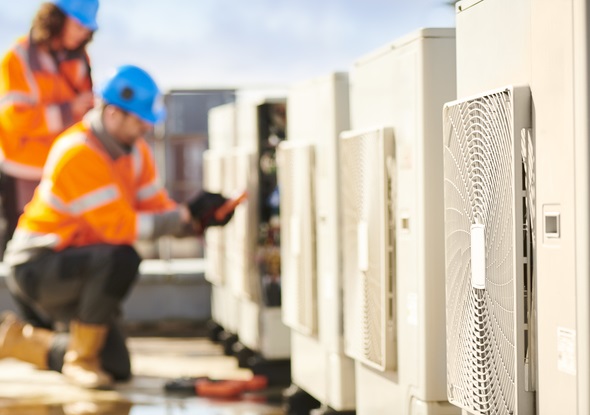What is an HVAC System?
Reading time: 4 minutes
How does an HVAC unit work?
A great piece of technology when a property owner is looking for a control system capable of cooling, heating and ventilating a space depending on their needs, HVAC systems function by circulating air from outside to interior environments.
This air is then put through one of the unit’s following components, depending on whether someone wants to warm up or cool down a room:
-
Air conditioning component – This part of a HVAC system will cool air to lower the temperature of a room, as well as control humidity throughout a space.
-
Heating component – Usually a central heating system like a heat pump or a boiler, this element of a HVAC unit will increase the temperature of air.
-
Ventilation component – This is the part of a HVAC unit that ensures there is a regular stream of fresh air circulated around rooms in a property.
A filtration system on this element of a HVAC system is also there to remove moisture, fumes and harmful particles from air before it enters interior rooms.
It is also important to point out that HVAC systems are not the same as air conditioning units. Air conditioning systems are designed to purely cool the air in a building. However, HVACs encompass all three heating, ventilation, and air conditioning systems into one unit.
HVAC units are available in several types of designs too, with the choice depending on what the property owner requires from the system. HVAC systems that you may be asked to install include all of the following:
-
Duct-free split unit – These systems allow individual units to be set up in each room of a property, so that energy does not need to be wasted when used in rooms that are not being occupied.
-
Geothermal unit – A very energy-efficient system that provides heating and cooling elements using the stable temperature of the earth, delivered to a property through underground pipes.
-
Heating and conditioning split unit – These energy-efficient systems are designed so that the air conditioning part of the technology sits outside of a property. The fan and coil components are then fitted inside a property, with ductwork connecting everything together.
-
Hybrid split unit – Another energy-efficient HVAC system that is similar in many ways to a heating and conditioning split unit, hybrid split systems do have some key differences.
An electric hybrid heating system allows property owners to easily switch from electric power and gas to suit their requirements, for instance, while thermostats are used to provide enhanced control when conserving energy.
Benefits of a HVAC system
Tradespeople may find they are getting more requests to install HVAC systems around properties, due to the many benefits that these units present to owners.
Air filters and fans designed onto these units will make sure temperatures remain comfortable and consistent around rooms, while those designed with thermostats help people to better monitor and control the energy they are using.
HVAC systems can also add value to a property once installed, even if the initial costs can seem expensive, while the technology has a long lifespan so has a great return on investment.
The ventilation and air filtration elements of an HVAC unit work to enhance the quality of the air that is inside a property too.
Key points to remember to get HVAC installation right
Property owners are encouraged to use a qualified HVAC installer when investing in these units, so you may find yourself with plenty of requests once you are qualified for this work.
As a qualified professional, you will have the knowledge to:
-
Carry out a thorough site inspection to ensure the correct placement of a HVAC system, bearing in mind that a unit for a small room will have different requirements than one that will function around multiple rooms in a property.
-
Safely and efficiently connect the electrical components of the HVAC unit, as well as ensure the system meets relevant Building Regulations Approved Documents, guidelines and regulations.
-
Fix the HVAC system securely onto walls or ceilings around a property.
-
Test the unit once installed to pinpoint any issues with airflow, performance or leaks which will affect how the system operates.
For more tips on how to keep properties in their best possible condition, be sure to browse through the buying guides, installation help pieces and advice articles which make up our huge home maintenance advice hub.
Disclaimer: The information contained on this page is intended as an overall introduction and is not intended as specific advice from a qualified professional. Travis Perkins aims to avoid, but accepts no liability, in the case that any information stated is out of date.




